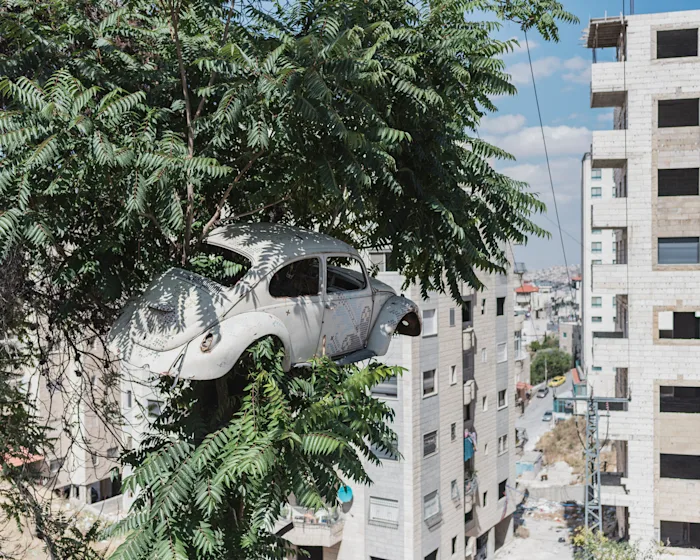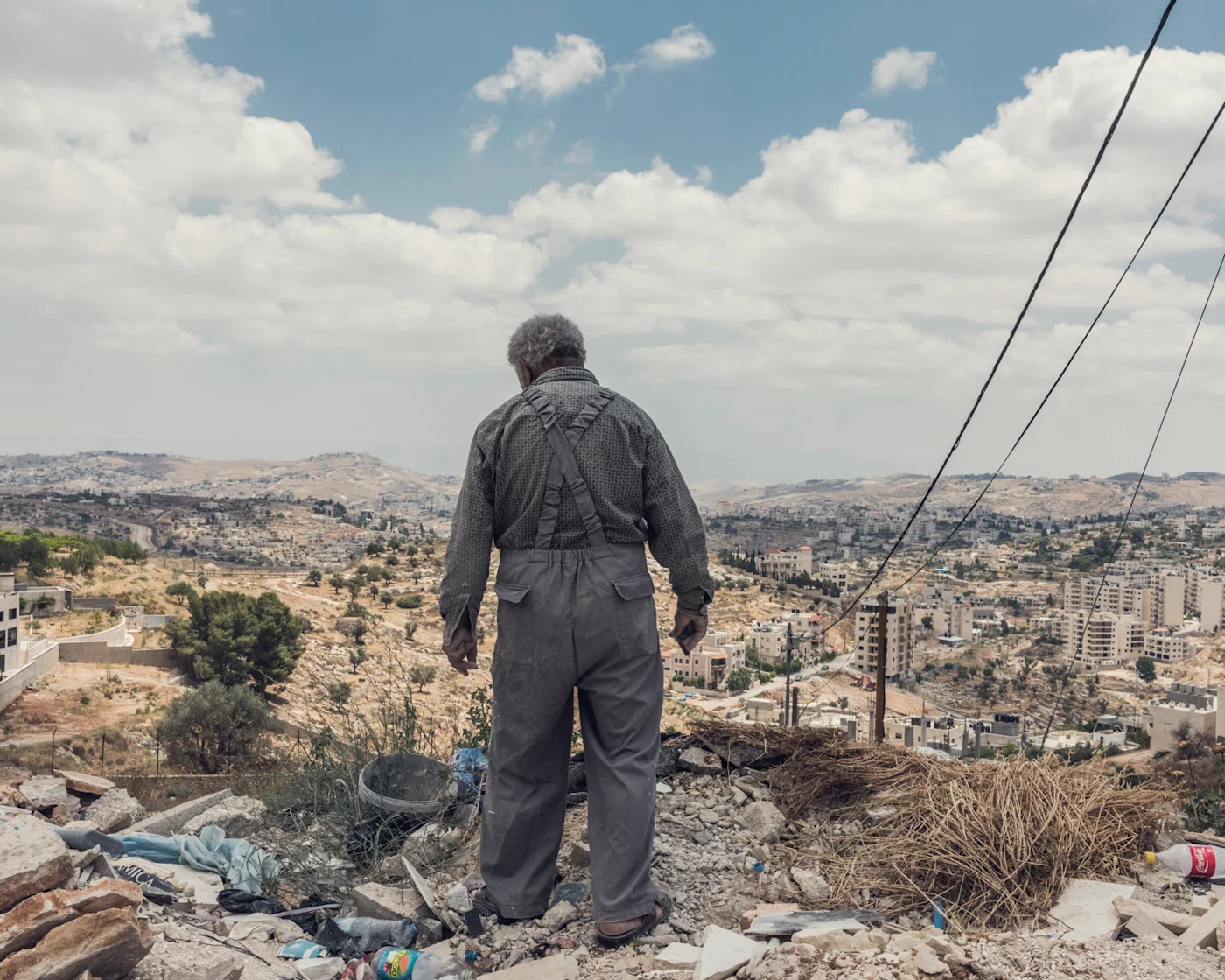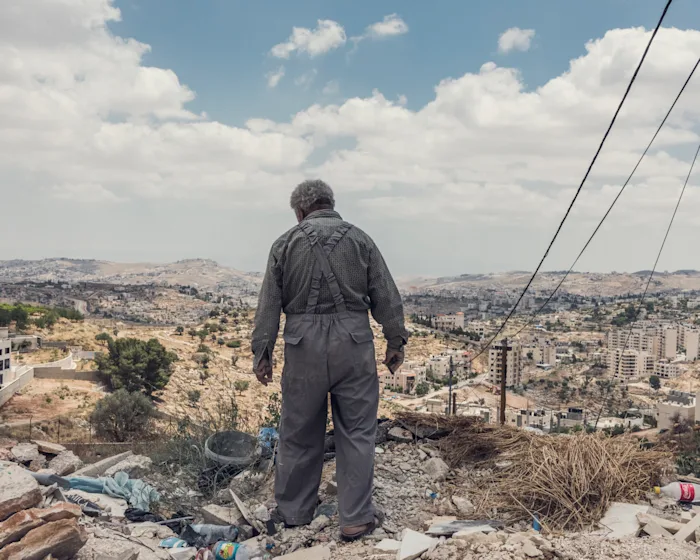Between the Sea and the Security Fence
Ian Alan Paul
Other languages: Türkçe, Polski, Français, Español, 日本語
Across Gaza’s fragmented collage of architectures and ruins, the abstraction of life rivals life itself. Subsumed by social technologies that densely blanket and code the territory without pause, lives are so exhaustively represented and recognized as this or that kind of life that it is the easiest thing in the world to forget that anything actually remains living beneath the thick waves of identification and classification. Refugee, militant, civilian, hostage, prisoner, soldier, and victim — these are the abstract coordinates that position lives within various military stratagems, political maneuvers, and economic programs, the particular forms of identity that are each coupled with their own particular shades and intensities of violence, the circulating codes that establish what a life is in ever higher detail, only to further establish what can be done to it. To live and die as an abstraction: this is the fate imposed on all who inhabit the space between the sea and the security fence.
Abstraction is real to the degree that it determines a life’s form and its lived conditions, granting or denying access through a checkpoint, flipping on and off water and electricity, providing momentary cover or painting a target on your back. Palestinian or Israeli? Muslim or Christian or Jewish? Man or woman? Citizen or refugee? What kinds of life might possibly be lived and what kinds of death may inevitably arrive come to be determined by an abstract calculus that ranks and sorts on the basis of these terms, shifting around and reorganizing sexualized and racialized hierarchies of lives, integrating each identity as a variable of a unified colonial operation. Each life in Gaza is steadily suffocated by all of the ways they’re represented and recognized by the forces that dominate them, by all of the ways life is subsumed and subordinated as one of many coded and categorized lives, by all of those predicates that facilitate the abstraction of life, and in so doing, facilitate its ongoing subjugation and eradication.
When international observers demand that the indiscriminate killing must stop, what they fail to comprehend is that the killing ceaselessly becomes more discriminating and discerning, always more individuated and informed, but that doesn’t make it any less devastating or total. As Israeli soldiers prepare to expunge life from large swaths of Gaza, they do so with data that pinpoints the cell phone locations of those who have chosen to remain and resist the army’s evacuation orders, adding resolution to and helping to refine their planned desolation. Drones persistently buzz overhead, surveying fleeing families piling onto truck beds so as to help generals optimize their bombardments. Water is shut off and food and medicine shipments are throttled or halted, all while Israeli bureaucrats count the calories consumed by the incarcerated population. It’s likely that Israel knows more about who they’re obliterating than any other regime in history, a knowledge that doesn’t even partially arrest but only augments the violence. The more each life is abstracted within the colonial situation, the more that each life is captured, calculated, and circulated as this or that kind of Palestinian life, the more sharpened the killing can become. Within the colonial armature, the abstraction of life is neither immaterial nor indiscriminate, but rather is designed to tactically enhance the domination of life: the tightening of its control over information and identities is only ever the prelude to the tightening of control over territories and bodies.


As periodic deluges of bombs break windows and blast apart neighborhoods, lives sheltering in this home or that hospital may wonder whether their deaths will be counted as a faintly regrettable civilian casualty or a successfully neutralized terrorist, be collected as a data point for a military commander’s combat simulation or as another entry in a United Nations spreadsheet, be memorialized as a martyr on a political party’s banner or as an online post to be quickly scrolled past. Walking down the street in search of dwindling groceries in the midst of the surrounding blockade, those same lives’ thoughts might drift instead to the satellites that track each of their movements from low orbit in preparation for the coming ground invasion, or perhaps to the drones that stream footage of crowds in hopes of matching faces with biometric profiles in military databases, wondering whether they’ll simply be surveilled as another inconsequential detail of the hostile terrain, or be targeted for erasure from the map. As missiles are fired off to detonate what had just been abstracted, families decide whether they should shelter together in a single room so they might at least die together, or whether they should spread out among multiple buildings so at least part of the family might survive and live on. The abstract edge of Israeli apartheid gives form to life only so lives can be exposed to ever more numerous regimes of death, documenting so as to better dispossess, sorting so as to better starve, representing so as to better bring to ruin.
It is on the basis of life’s abstraction that lives can be so carelessly and effortlessly substituted by lists of their predicates, through which a life can be computed, contemplated, and potentially culled as if it were simply a set of its discrete and described properties. Concatenated accumulations of ID cards, police files, population databases, and government permits shape the terrain within which life is lived, shifting the contours of where a life can and cannot study and move and shop and build and work, as well as what healthcare and food and water a life can or cannot access. While life and death may elude any total or final definition — witnessing a life being born or passing away often leaves us without words, speechless — their abstraction nonetheless prepares the ground so that even the most extreme forms of devastation can nonetheless fluidly roll off of freshly numbed and lubricated tongues: “a million Gazans ordered to flee,” “neighborhoods sheltering Hamas to be wiped away,” “all who remain are responsible and must pay a price.” What is genocide if not the moment when an abstraction finally suffocates everything it enfolds and encompasses, finally squeezes all of the life out of what it so definitively catalogs and circumscribes? No genocide proceeds without its own codes and classes of life, without moving to eradicate precisely what it abstracts.
To speak of war and peace in Palestine is simply to speak the names of two modalities of a unified abstract process, one which delivers death abruptly and the other which delivers death procedurally, measuredly, apportionately. Aerial bombings and arbitrary arrests, border checkpoints and economic blockades, indefinite detentions and targeted assassinations, bulldozers and barrages of tear gas: these are only the most obvious and widely documented technologies that ever more numerously choke what remains struggling to live. In each case, the abstract works to optimize and rationalize all of the violence that relentlessly circulates, to classify life so as to better calculate and complete its destruction, to give form to a war and peace that only promise to annihilate you at different speeds.
As the diverse cacophony of lived experience is abstracted away within the coordinates of this or that ethnic or religious history, this or that political party or faction, this or that historical trauma or ancestral claim — abstractions which then go on to determine the conditions of survival within which a life lives — it’s no wonder that lives can come to wholly identify with their abstraction, to see their abstraction as themselves. This is in some sense a deeply pragmatic fact, in the sense that the struggle to survive has been coupled with the representation of the survivors, through which lives live in the narrowing avenues of existence that are held open by those who claim to represent them. Hamas in Gaza and the Palestinian Authority in the West Bank are each content to be the outsourced administrators of this abstract colonial regime, working to both rigidly represent and precariously provide for Palestinians while at the same time policing Palestinian lives and repressing whatever compromises their abstract monopoly. While Hamas promises to destroy Israel and the Palestinian Authority promises to cooperate with it, both function as complementary extensions of the occupation’s abstraction, one representing hostile lives to be exterminated and the other representing pacified lives to be expelled.


Life's identification with its abstraction is also a political one, as seeing oneself as Palestinian is to understand that you share a common history with other Palestinians, that you have a shared tradition of survival and struggle because you all have been subjected to a shared process of dispossession and domination. The abstractions that thickly flow across Palestine don’t simply imprint themselves upon life in this sense, but also emerge as forms which lives are drawn to and become implicated in. Subjectively taking form in various identities and nationalisms, the abstraction of Palestine does not simply function as a mode of repression, but also as lived experience and social context where people who have been subjugated together search for methods of surviving and revolting together. These struggles always ignite from within the colonial abstraction, but what remains decisive is whether they orient themselves towards preserving and perhaps securing a modicum of sovereignty over their abstract existence, or they aspire to explode it once and for all. In Palestine and across its diaspora, there are those who remain undetermined by all of the ways they have represented and recognized, who search for one another in the remnants and ruins of their shared past, and who fight for a Palestine liberated from its colonial abstraction.
What is this Palestine that could succeed in escaping its colonial abstraction, that could manage to incinerate what represents and identifies it so totally, that refuses to be eradicated and revolts against what eradicates? A Palestine that has thrown off its abstraction would be one less concerned with any particular identity and more formalized as a creative and insubordinate movement, less organized by what it is and more by what it can do. It would be a Palestine that arises from those forms of life which can be grasped only as turbulence and dissonance by those who would desire to police their form and impose forms upon them, those forms of life who have become autonomous and free to the degree that they can play with their form as one can play in the tumbling waves of a beach. These forms of life live as multiplicities, as ensembles and as part of ensembles without any need of unity, as lives who live in opposition not to other coded forms of life but rather in opposition to their abstract desolation and determination. They live a form of poiesis that can be described just as Aimé Césaire describes poetry: as a descent into oneself, but also as an explosion. What we are left with is not this or that kind of life, but rather a life that ruptures any container one may attempt to lock it within.
This insurrection against abstraction doesn’t entail the disappearance of Palestine, but rather the disappearance of the colonial world that has functioned only to capture and constrict, to cut apart and contract. A Palestine mapped and scanned ever more exactly by colonial forces, a Palestine that emerges simply as an accumulating archive of its discrete attributes and abstract properties, is a Palestine that exists only as the shadow of what dominates and codes it, as the inverted symmetry of its occupation. The end of the colony in this sense entails not only the end of the colonizer but also of the colonized, abolishing colonial abstraction as a means of abolishing the colony and its determination. Only when Palestine is able to accomplish this insurrection against its abstraction, only when it escapes its abstract existence as the shrinking remainder of Israeli expansion and domination, will we truly be able to begin learning what Palestine is and can be.
Here and now, even in anticipation of the militarized desolation that awaits its full and terrifying deployment across Palestine, there remains an effervescent revolt of those who defend the radical singularity of life and attack life’s colonial abstraction, who live within forms of life that are wholly incongruent and incommensurable with the surrounding regimes of abstract violence: the insurgents of Gaza who stage attacks on the fence and organize resistance against Hamas’ repressive forces, the anarchists within Israel who refuse conscription and take sledgehammers to the separation wall, the grieving families who do not allow their dead to be taken as symbolic cannon fodder for the next round of killing, the saboteurs who set fire to surveillance cameras in East Jerusalem and dismantle checkpoints in the West Bank, and those who break apart the partitions that have been built around so many identities and find themselves sitting instead in an immense constellation of lives.
Between the sea and the security fence and the river and the sea remain all of those lives who struggle alongside their neighbors for futures that spiral out across a shimmering multiplicity and unrepresentable diversity of Palestinian forms, unconstrained by codification and identification, no longer determined by the colonial abstraction and domination of life. Everything depends upon proliferating and intensifying and acting in solidarity with the force of those lives that refuse the abstract domination of life, that don’t premise their own form on the violent separation and tireless eradication of forms, that threaten to bring an end to the colonial world so that we might possibly live in another.
October 2023
Images: Clément Chapillon